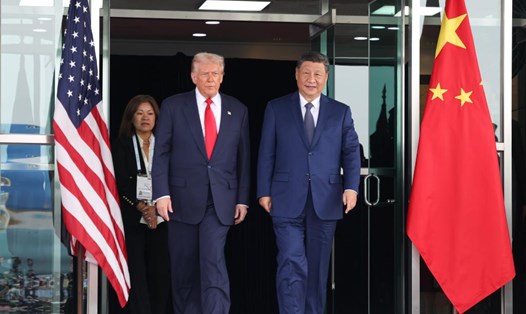Achieving strategic consensus
The negotiation results are that the US-China relationship has almost achieved mainly on the principle of " giving back". China has agreed to import 87 million tons of US soybeans, including 12 million tons in 2025 and 25 million tons per year for the next 3 years.
First, the US has lifted a 10% tax rate on "fentanyl" applied to Chinese goods, postponed a year of anti- whole-match tariffs of 24% on Chinese goods, and both sides agreed to extend some tariff exclusion.
Second, the US temporarily suspended the 50% export rate limit announced on September 29 for 1 year. China has suspended for a year the export control measures announced on October 9 and studied to adjust specific plans.
Third, the US suspended one year of Article 301 investigations into China's maritime, logistics and shipbuilding sectors. Accordingly, China will also temporarily suspend retaliatory measures against the US for 1 year.
In addition, the two sides agreed on cooperation in controlling fentanyl, expanding agricultural trade and handling individual cases related to related companies. The two sides affirmed the results of the trade consultation in Madrid, with the US making goodwill commitments in areas such as investment. China cooperates with the US to properly resolve the TikTok issue.

Impact on the rest of the world
The efforts to reach the above consensus, although only temporary in one year, contributed to unblocking the explosive momentum of the US-China trade war "waiting for" to flare up fiercely, showing that both sides are eager to move on to further, broader and more comprehensive agreements but still try to avoid risks. These initial results show that the fierce economic - trade - technological competition between the US and China still has factors that can be unified in the short term and both sides do not over- promote their own interests without taking into account the interests of the other side.
This shows that US-China tensions have cooled down significantly, the world is almost entering a temporary "calm" state to continue moving towards a broader or longer state of calm or can prepare for another outbreak of tension when there is a new tool in the relationship that is more effective and creates greater benefits than the current scenario.
Although only temporarily calmed down, positive signals from the stock market with the increase in stocks and soy prices show that this negotiation result is positive. In particular, both the US and China see it as a benefit.
The US-China agreement to ease tensions shows that countries still value stability for development and that it is a support for mutual development, creating more benefits instead of tension, embargoes, retaliation that damage the interests of all parties. The principle of winning in negotiations is still applied by both sides. The US taxi-taking and negotiation approach has a certain effect and can continue to be applied if it benefits the US on the America First principle.
Choices of Vietnamese enterprises
In the face of the above situation, Vietnamese enterprises need to pay attention to connecting the supply chain of goods with high comparative advantages to create a stable source of export goods, avoiding market decline. At the same time, Vietnamese enterprises also need to pay attention to deep cost savings such as production, administrative, logistics costs, and informal costs to increase competitiveness with goods from other countries in the US market. Promote the building of Vietnamese brands to develop into global brands, especially pure Vietnamese products.
Vietnam also needs to have a plan to exploit the potential of rare earths to participate in exporting this strategic item in conjunction with the completion of legal regulations to manage the export of this strategic item as a basis for international negotiations when necessary.
There should be different scenarios to proactively and actively adapt to the possibility of adjusting US-China relations. If tensions break out even though the possibility of occurring is not high, Vietnamese enterprises need to take advantage of this to speed up exports to the US and also need to pay attention to the counterpart principle in the commitment. If tensions ease, businesses need to focus on deep connections with US partners along with diversifying to other new markets, which may not be easy but need to prepare in advance to avoid sudden impacts of market decline due to competition.
Management agencies need to have an early warning mechanism for businesses to support when necessary. This also requires a flexible diplomatic policy, complying with the principle of the sovereign national interest but being flexible when necessary. Commitments also need to be foreseeed of unfavorable fluctuations, so there should be commitments that should be temporary to create a period of peace in trade to accumulate resources, speed up production and create reserve resources to minimize unfavorable and unexpected impacts.
The companionship between the Government and businesses, the companionship of the business community with other Associations and useful partners need to be valued at the same time as the development of diverse, comprehensive, proactive, positive and substantial strategic partnerships.











